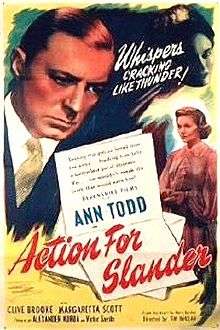Action for Slander
| Action for Slander | |
|---|---|
 | |
| Directed by | Tim Whelan |
| Produced by |
Victor Saville Alexander Korda |
| Written by |
Mary Borden (novel) Ian Dalrymple Miles Malleson |
| Starring |
Clive Brook Ann Todd Margaretta Scott |
| Music by | Muir Mathieson |
| Cinematography | Harry Stradling |
| Edited by | Hugh Stewart |
Production company | |
| Distributed by | United Artists |
Release dates |
|
Running time | 83 mins |
| Country | United Kingdom |
| Language | English |
Action for Slander is a 1938 British drama film directed by Tim Whelan and starring Clive Brook, Ann Todd and Googie Withers. An army officer is falsely accused at cheating at cards by a man whose wife he had an affair with and struggles to clear his name. It was an adaptation of the 1937 novel Action for Slander by Mary Borden.
Synopsis
Major George Daviot is left by his wife Ann due to their growing estrangement and her knowledge that he has fallen in love with another woman, Josie Bradford, the wife of one of his fellow officers. Daviot goes off with friends for a weekend party at a country house attended by a number of prominent figures including businessmen and politicians as well as Captain Bradford and his wife. The tension between Bradford and Daviot is obvious during grouse shooting as Bradford is clearly aware of Daviot's affair with his wife.
That evening, during a game of cards played for high stakes, Daviot is accused of cheating by Grant, a drunken player who has lost large amounts of money, a charge that is dismissed out of hand by the other players until Bradford seconds it. None of the other players believe the accusation, even though they are unaware of the grudge that Bradford has against Daviot. Bradford sticks to his story, even in the face of legal action from Daviot.
The other guests frightened of their own reputations if the scandal becomes widely known, persuade all to hush the matter up. Daviot agrees to keep quiet for all their sakes, even though he still wants to clear his name. Daviot proposes to Josie that she leave her husband and live with him in spite of the scandal, but her lukewarm response leads him to realise that her interest in him is shallow. She subsequently reconciles with her husband and they go abroad to spend time together.
Daviot tries to continue, but rumours about the affair begin to spread. Over the following year, his life disintegrates. He no longer finds himself welcome in his regiment or at his gentlemen's club and his friends begin to cut him socially, including those at the house party who know him to be innocent. Hounded out of his society, Daviot retreats to a cheap boarding house in Bayswater where he ceases to go out or even open letters. His one remaining hope, of receiving a transfer to the Indian Army serving on the Northwest Frontier is dashed and he begins to consider suicide.
Ann Daviot, meanwhile, has been touring around Continental Europe aimlessly, possibly never to return to Britain. As soon as she hears he is in trouble she returns to help him, but he is unresponsive and derides her as an "Angel of Mercy". Eventually she goads him into facing his accusers, and he initiates court proceedings on the understanding that if he loses he will be allowed to take gentlemen's way out with a pistol. With the help of his barrister Sir Quinton Jessops, Daviot attempts to clear his name by suing Bradford and Grant for slander.
Production
The film was made independently by Victor Saville with backing from Alexander Korda's London Film Productions.[1] It was adapted from the novel Action for Slander by Mary Borden that was released the same year.[2]
Reception
The film was popular at its release and it was re-released several times during the 1940s. However, it has later been criticised as "stilted". Rachael Low describes it as being "well-made and acted" although the "behaviour of the characters was too far-fetched to carry conviction".[3]
Cast
- Clive Brook - Major George Daviot
- Ann Todd - Ann Daviot
- Margaretta Scott - Josie Bradford
- Arthur Margetson - Captain Hugh Bradford
- Ronald Squire - Charles Cinderford
- Athole Stewart - Lord Pontefract
- Percy Marmont - William Cowbit
- Frank Cellier - Sir Bernard Roper
- Anthony Holles - John Grant
- Morton Selten - Judge Trotter
- Kate Cutler - The Dowager
- Enid Stamp-Taylor - Jenny
- Francis L. Sullivan - Sir Quinton Jessops
- Felix Aylmer - Sir Eustace Cunninghame
- Laurence Hanray - Clerk of Court
- Gus McNaughton - Tandy
- Googie Withers - Mary
- Albert Whelan - Roper's butler
- Allan Jeayes - Colonel
References
External links
Bibliography
- Low, Rachael. The History of British Film: Volume VII. Routledge, 1997.
- White, Terry. Justice Denoted: The Legal Thriller in American, British, and Continental Courtroom Literature. Praeger, 2003.